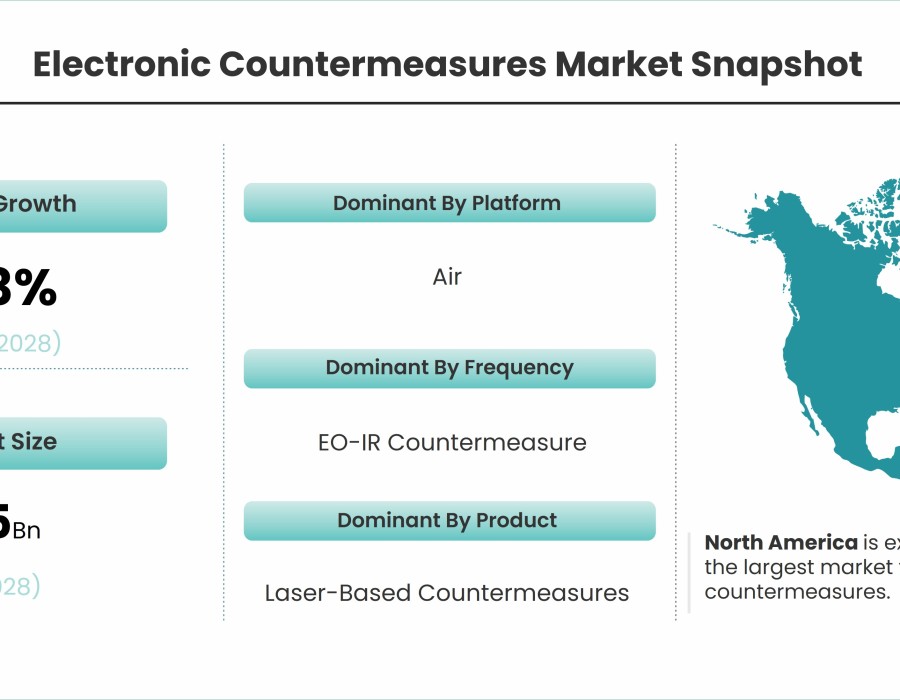In the evolving landscape of modern warfare, electronic countermeasures (ECM) have become indispensable for military forces worldwide. Electronic countermeasures technologies are designed to disrupt, deceive, and deny adversary electronic systems, safeguarding friendly forces and enhancing operational effectiveness. This article delves into the key technologies behind electronic countermeasures and their diverse applications in contemporary defense strategies.
According to Stratview Research, the electronic countermeasures market is likely to grow at a promising CAGR of 4.3% during 2023-2028 to reach an estimated value of US$ 5.0 billion in 2028.
Key Technologies in Electronic Countermeasures
· Jamming Systems: Jamming is one of the most fundamental electronic countermeasures techniques. It involves emitting radio frequency signals to interfere with enemy radar, communications, and navigation systems. By overwhelming these systems with noise or false signals, jamming effectively disrupts the enemy’s situational awareness and command-and-control capabilities.
· Decoys and Deception: Decoy technologies, such as chaff and flares, are used to mislead enemy radar and infrared-guided missiles. Chaff consists of tiny metallic strips released into the air to create false radar targets, while flares generate intense heat to divert infrared-seeking missiles away from their intended targets.
· Electronic Protection Measures (EPM): These technologies protect friendly electronic systems from enemy electronic countermeasures efforts. EPM includes frequency hopping, spread spectrum techniques, and adaptive filtering, ensuring that communication and radar systems can withstand jamming and other interference.
· Radar Warning Receivers (RWR): RWRs are essential for detecting and identifying enemy radar emissions. These receivers alert operators to the presence of hostile radar, enabling timely evasive maneuvers or the deployment of countermeasures.
· Signal Intelligence (SIGINT) and Electronic Support Measures (ESM): SIGINT and ESM technologies involve intercepting and analyzing enemy electronic emissions to gather intelligence. This information is crucial for understanding enemy capabilities and intentions, and for planning effective electronic countermeasures strategies.
Applications of Electronic Countermeasures
· Airborne Platforms: Electronic countermeasures technologies are integral to the defense systems of modern aircraft. Fighter jets, bombers, and reconnaissance planes are equipped with advanced jamming pods, RWRs, and decoys to evade enemy air defenses and ensure mission success.
· Naval Vessels: Warships employ electronic countermeasures systems to protect against anti-ship missiles and other threats. Naval electronic countermeasures includes powerful jamming systems, decoy launchers, and electronic surveillance measures to safeguard fleets during operations.
· Ground Forces: Land-based electronic countermeasures systems are used to protect troops and equipment from enemy surveillance and targeting. Mobile jamming units, electronic warfare (EW) vehicles, and portable RWRs enhance the survivability of ground forces in contested environments.
· Space-Based Assets: With the increasing militarization of space, electronic countermeasures technologies are being developed to protect satellites and other space assets. These systems ensure secure communication and navigation, and counter adversary attempts to disrupt or destroy space-based capabilities.
In conclusion, electronic countermeasures are a critical component of modern defense strategies, employing sophisticated technologies to protect and enhance military operations across air, sea, land, and space domains. As threats evolve, the continuous advancement and integration of electronic countermeasures technologies will remain vital to maintaining military superiority and operational effectiveness in the complex battlespace of the future.






Comments